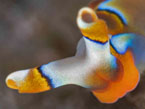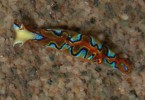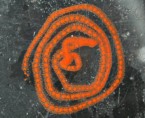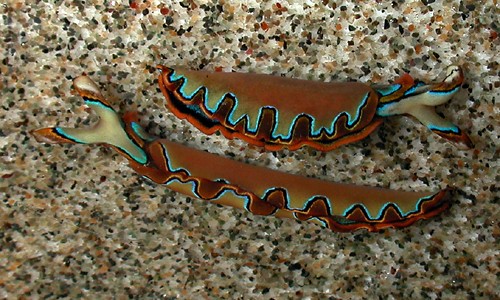| Home |
| Acknowledgments |
| Conventions |
| Glossary |
| Maps |
| References |
| Links |
| Articles |
| Thumbnails |
| Species
list |
| Family |
| Next
species |
Additional Photos

detail

underside

side

front

interior

reduced brown

enhanced green

young, about 4 mm

mating

egg mass
_______________
GALLERY

Thuridilla neona Gosliner, 1995

| Maximum size: 23 mm. Identification: This species has a brown-cream body with sky blue, black and orange banding on its parapodia and rhinophores. The parapodia are low and meet in the center without obvious chimneys. It can be distinguished from Thuridilla multimarginata by its orange-brown marginal line and the undivided cream patch on top of its head. Natural history: Thuridilla neona is a common species found on rocky bottoms. It occurs in protected to moderately exposed locations at depths of < 1 to 3 m (< 3 to10 ft). Rarely, it may be found to 12 m (40 ft). Mature animals are diurnally active and may form mating aggregations. (Note 1) This, combined with its striking color, makes it the most readily seen of the rock-dwelling plakobranchids in Hawaiian waters. The egg mass is a tightly to loosely coiled orange spiral and there are granules of bright orange extra-capsular yolk in the center of the ribbon. The eggs hatch in about 6 days in the laboratory and the pigmented granules remain in the mass after hatching. Distribution: Big Island, Maui, Lanai, Oahu, Kauai, French Frigate Shoals, Lisianski and Midway: also known from Australia. Taxonomic notes: It was first recorded in Hawaii from Hale'iwa, Oahu by Earthwatch expedition participants in July, 1980 and was named after its "neon" colors. Photo: CP: 10 & 12 mm: Hekili Point, Maui; Dec. 1, 2002. Observations and comments: Note 1: On many occasions over a period of several weeks in Aug. and Sept., 1987 numerous animals were found crawling in the open on a ridge of senescent Porites compressa at 1-1.5 m (3-5 ft) in the back reef at Hekili Point, Maui. They occupied an area of around 6-8 square meters with as many as 10-12 sometimes in view at once. The animals gathered in small groups at the tips of dead P. compressa branches and we may have seen copulating pairs in the field. Orange egg masses comparable to those laid in the laboratory were found on the undersides of coral rubble in the area. A smaller, though otherwise similar, aggregation was found in the same area in Sept., 1988. In Sept., 1990 another aggregation was found in a similar location about 2 km east of Hekili Point. Whether this indicates a consistent tendency to form mating aggregations or just represents a local concentration of food/habitat is unknown. |
| Thumbnails |
Species
list |
Family | Next species | Top |